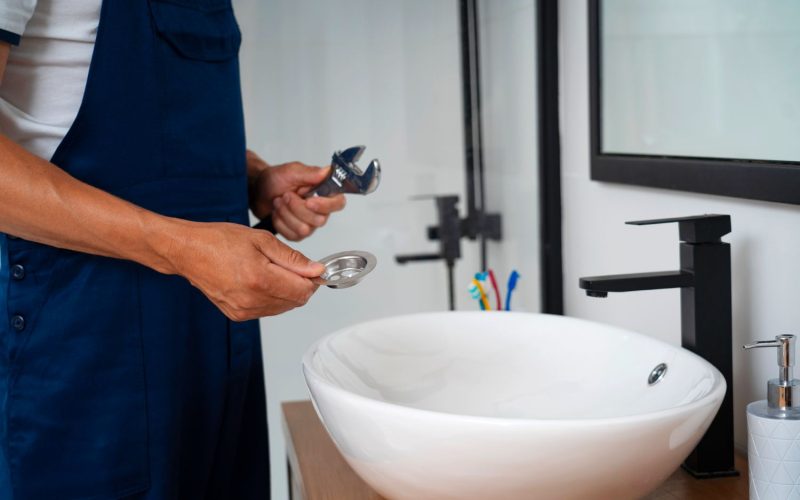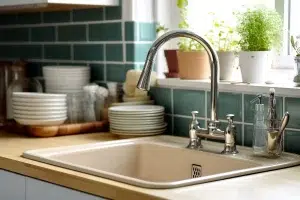Dealing with a bathroom faucet leaking at the base can be both frustrating and wasteful.
Whether it’s a result of a deteriorated faucet seat washer, issues with gooseneck faucets, or persistent dripping, addressing the problem promptly is crucial.
In this guide, we’ll explore practical steps to tackle a leaking basin faucet, covering essential aspects like identifying the root cause, gathering necessary tools, and executing effective repairs.
From faucet seat washers to gooseneck faucets, understanding the intricacies involved in fixing a faucet leaking under the sink ensures a sustainable solution to combat water wastage and maintain a leak-free basin.
Table of Contents
ToggleCommon Causes of Faucets Dripping Water
Here are the common causes of a dripping faucet, with added information to each item:
Worn-Out O-Ring
Positioned at the faucet handle’s base, the O-ring can degrade over time, leading to seeping water.
Regular inspection and replacement are essential to prevent leaks and maintain the faucet’s integrity.
Loose or Damaged Handle
A loose or damaged handle, stemming from wear and tear, can result in water escaping from the faucet.
Routine maintenance, including handle tightening and inspections, is crucial to prevent potential leaks.
Corroded Valve Seat
Corrosion of the valve seat can hinder proper sealing, causing leaks. Utilizing corrosion-resistant materials and regular cleaning can mitigate this issue, ensuring the valve seat’s functionality.
Faulty Washer
A faulty washer can compromise the creation of a watertight seal, leading to leaks. Regularly inspecting and replacing washers as part of maintenance helps prevent water seepage.
Water Pressure
Excessive water pressure can induce faucet dripping. Installing a pressure regulator or maintaining a consistent water pressure level helps prevent wear and tear, reducing the likelihood of leaks.
Improper Installation/Loose Parts
Incorrectly installed or loose parts may contribute to leaks. Following proper installation procedures and ensuring all components are securely fitted minimize the risk of faucet dripping.
Defective Parts
Defective components like o-rings, washers, and gaskets can lead to sink faucet leaks.
Opting for high-quality replacement parts and addressing defects promptly contribute to a well-functioning faucet.
How To Fix Dripping Faucets in 8 Practical Steps

Here are the steps to fix a dripping faucet with additional information for each item:
Step 1: Turn Off the Water
Before any repair, shut off the water supply to the faucet. This ensures a safe and controlled environment for the fixing process.
Step 2: Identify the Type of Faucet
Determine the faucet type—cartridge, compression, ceramic disk, or ball-type. Identifying the specific type aids in understanding the internal mechanism for effective repairs.
Step 3: Gather Necessary Tools
Collect tools such as an adjustable wrench, screwdriver, plumber’s tape, and white vinegar. Having the right tools on hand streamlines the repair process.
Step 4: Disassemble the Faucet
Remove the handle and other components to gain access to internal parts. Disassembling the faucet is essential for a thorough inspection and targeted repairs.
Step 5: Inspect and Replace O-rings, Washers, and Valve Seats
These components are common causes of dripping. Inspect for wear, tear, and corrosion, replacing any damaged parts. This proactive approach addresses common issues contributing to leaks.
Step 6: Clean the Parts
Use white vinegar to clean components before reassembly. Cleaning helps remove mineral deposits and ensures optimal functionality when the faucet is put back together.
Step 7: Reassemble the Faucet
Put the disassembled parts back together systematically, following the reverse order of disassembly. Ensuring proper alignment and connection is crucial for the faucet’s effective operation.
Step 8: Test the Faucet
Turn on the water and check for any leaks. If dripping persists, additional steps, such as replacing the cartridge or other internal components, may be necessary for a comprehensive fix.
By meticulously following these steps, you can efficiently address a dripping faucet, contributing to water conservation and preventing unnecessary wastage.
Key Takeaway
When confronted with a dripping faucet, a systematic approach involving the consideration of potential causes becomes pivotal.
By proactively conducting thorough inspections, implementing regular maintenance practices, and strategically replacing worn-out components like O-rings, washers, and valve seats, homeowners can effectively diagnose and address the issue.
This diligent process not only resolves the immediate concern but also contributes to prolonged faucet health, preventing unnecessary water wastage and promoting sustainable household practices.
In other cases, your basin faucet manufacturer will provide a product manual or care instructions.
But if leakage persists, it’s best to contact a plumber.




